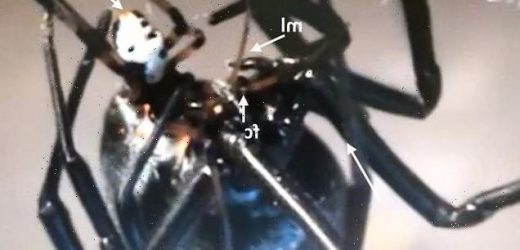Female black widow spiders start EATING their partner before they’ve even finished mating – before moving on to another male
- Cannibalism initiated by females with leg grasping and piercing during mating
- Males cannibalised during sperm transfer as the result of the female’s behaviour
- Females re-mate, meaning consumed males might lose paternity to future rivals
Female black widow spiders start eating their partner in the middle of sperm transfer during copulation, a new study shows.
Researchers in Canada have described the disturbing mating behaviour of a black widow spider species endemic to South America, called Latrodectus mirabilis.
Cannibalism between the two sexes is initiated by females ‘through leg grasping and piercing during mating’, they reveal from lab observations.
Overall, 70 per cent of females cannibalised their first mate, they observed, but this number jumped to 85 per cent if the female had mated previously.
The freshly deceased cannibalised male might also be less likely to become a parent, because the female is then free to copulate with other males.
Gruesome video footage shows an unfortunate male dwarfed by its relatively gigantic lover in his final moments.
Scroll down for video
Images of female and male Latrodectus mirabilis during mating trials. In the early stage of mating the female is grasping the male’s leg (ml) with her chelicerae (fc) and piercing it with her fangs. Male’s abdomen (ma) is also marked
Scientists have found a new species of spider in Miami that looks like a ‘small shiny black tarantula’ and has venom that induces painful stings just like a bee.
The Pine Rockland trapdoor spider (Ummidia richmond) was first found by a zookeeper in the grounds of Zoo Miami in Florida.
With legs extended, the male is approximately the size of a one pound coin, while the female is estimated to be two to three times larger.
Ummidia is a trapdoor spider – meaning it lives in a burrow with a hinged cover like a trapdoor to hide from predators and snatch unlucky prey.
Read more: Terrifying new species of spider discovered in Miami
Sexual cannibalism in insects and arachnids is well documented and tends to be the dominant female killing and eating the male after mating.
Generally, the benefits of sexual cannibalism may include obtaining nourishment for reproduction or encouraging males to avoid mating with inferior females, previous studies show.
From the male’s point of view, it is evolutionarily beneficial for him to sacrifice himself for the good of his mate and his offspring, which benefit from his vital nutrients.
‘Usually there are some advantages to the male for being eaten during mating, like longer copulations as well as decreased female receptivity to future males,’ study author Luciana Baruffaldi at the University of Toronto told New Scientist.
‘In this case, though, we don’t yet know how the male benefits from sexual cannibalism.’
For the study, Baruffaldi and her colleague collected male and female L. mirabilis juvenile spiders from the field in Piedras de Afilar, Canelones, Uruguay.
The specimens were then held in plastic cages in the Clemente Estable Institute of Biological Research in Montevideo, Uruguay at room temperature.
Their development was monitored and the date they reached sexual maturity was recorded before males and females were introduced to each other and their interactions were filmed and analysed.
In the later stage of mating the female is piercing the male’s abdomen (ma) with her fangs while grasping the male’s body with her chelicerae (fc), and the male’s legs are encased in silk (s)
Adult females were placed in mating arenas for somewhere between 24 and 48 hours to construct webs prior to the introduction of males.
In all, 21 unmated females were paired with adult males – and only one of the females was not ‘actively courted’. Of the remaining 20, all females copulated at least once.
Nine of the 20 matings ended with only one copulation, mostly due to the female sexually cannibalising males during the first copulation.
Cannibalism started during copulation when females grasped the male’s legs with their chelicerae – their strong, fang-bearing front appendages – and pulled males’ abdomens to their mouths to start eating them.
In a second round of experiments, the team found 85 per cent of previously-mated females cannibalised their second mate.
Interestingly, sperm transfer is not prevented by cannibalism, but the fact females go on to mate with other males ‘reduces the possibility for benefits of cannibalism for males’, the experts say.
Other spiders in the Latrodectus genus practise sexual cannibalism during copulation.
Male redback spiders (Latrodectus hasselti) and brown widow spiders (Latrodectus geometricus) actually initiate the cannibalism by flipping themselves over to ‘offer’ their abdomens to the female, according to Baruffaldi.
The difference with L. mirabilis is that cannibalism was initiated by females, and not facilitated by males like these other species.
The new study, published in Behavioural Processes, describes a unique form of sexual cannibalism not previously reported for the genus.
A ‘VIOLENT STRUGGLE’: MALE COERCION AND FEMALE INJURY IN INSECTS
Dr Nathan Burke and Professor Holwell call sexual reproduction ‘rarely a harmonious affair’.
Sexual conflict over mating interactions can drive the evolution of behavioural or morphological traits that enhance the fitness of one sex at the expense of the other.
Typically, sexual conflict favours coercive traits in males that facilitate mating by force or intimidation.
In sexually cannibalistic insects where females consume males before, during or after mating, the greater burden of costs is borne by males.
Females can enhance reproductive output with the additional nutrients obtained through the cannibalisation of males, whereas males lose all future reproductive opportunities if they are consumed.
Therefore, male mating tactics are required that reduce the risk of cannibalistic attack.
Coercion seems to be an exception, however – males typically employ cautious strategies to secure matings and avoid cannibalism.
Examples of such strategies include males using stealth during mating approaches, courting females with a ‘decoy nuptial gift’, playing dead when females attack and preferentially mating with females that are feeding or moulting.
Rare examples of males mating coercively rather than cautiously can also be found in some sexually cannibalistic spiders.
These courting males immobilise females for mating by biting them, injecting them with venom, emitting airborne chemicals or tying them up with silk.
Such behaviour can potentially harm females by causing haemolymph loss or reduced foraging performance.
Source: Burke and Howell in Current Biology
Source: Read Full Article




